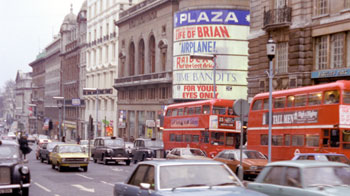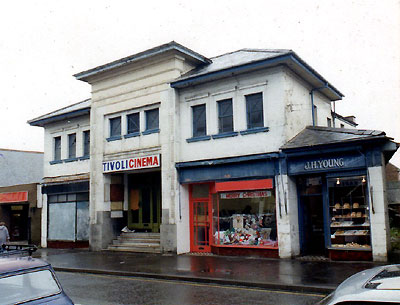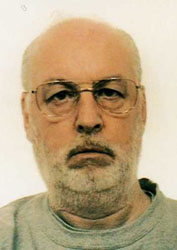My Life in the Cinema
|
Read more
at in70mm.com The 70mm Newsletter |
||||
| Written by: Robert Scott-Spencer, projectionist (retired), England | Date: 6 March 2005 | ||||
|
Further
in 70mm reading: 70mm Film in London Internet link: |
||||
 I use to go to the Saturday morning children film club at the “Odeon
Cinema Kemp town Brighton” which also held on a Wednesday during school
holidays. It was during one of the children film club meeting I managed to
worm my way into the projection box to have a look at the projectors (Kalee’s).
I must have said or done some right as instead having to leave after a few
minutes I was allowed to sit on a stool in the corner, to watch and talk
to the projectionists. It was not long before I was allowed to rewind the
film and shown how to splice the 35mm film. Then how to make up and take
down a programme. Then how to lace the projectors and how to do a change
over, it was not long before I know how start, run and end the show and
best of all do it my self. Even if someone was stand over all the time.
This Saturday and Wednesday treat last until the cinema was closed down
and the children film club moved to the “Regent Queens Road Brighton.”
Here I could not even get a look in the projection box let alone touch the
35/70mm projectors. Or when it moved from there to the “Academy Cinema
West Street Brighton.” I use to go to the Saturday morning children film club at the “Odeon
Cinema Kemp town Brighton” which also held on a Wednesday during school
holidays. It was during one of the children film club meeting I managed to
worm my way into the projection box to have a look at the projectors (Kalee’s).
I must have said or done some right as instead having to leave after a few
minutes I was allowed to sit on a stool in the corner, to watch and talk
to the projectionists. It was not long before I was allowed to rewind the
film and shown how to splice the 35mm film. Then how to make up and take
down a programme. Then how to lace the projectors and how to do a change
over, it was not long before I know how start, run and end the show and
best of all do it my self. Even if someone was stand over all the time.
This Saturday and Wednesday treat last until the cinema was closed down
and the children film club moved to the “Regent Queens Road Brighton.”
Here I could not even get a look in the projection box let alone touch the
35/70mm projectors. Or when it moved from there to the “Academy Cinema
West Street Brighton.” |
|||||
|
At the age of 15 I joined the army, after my basic training I joined my unit
I soon found there was a run down 16mm camp cinema/theatre. Which by the way
was used as a lecture hall and church. And as soon as I showed an interest
in it I was ship off to the Army Kinema Corporation for more training as a
projectionist, this included how to manage a permanent cinema and how set up
and ran a mobile cinema unit. At first this cinema was equipped with miss
match pair of Bell & Howell’s, I had these replaced with a pair of DeBrie’s,
complete with anamorphic lens and new slide projectors were also installed
at the same time. Later back stage in a storeroom, I found a pair of broken
Gaumont British L516’s. With the typical logic of the army it was assumed that if I could run the cinema, I could also run it as a lecture hall and theatre for live performances. At that point in time the only thing I had done as far as live performances were concerned, was working back stage for the school’s drama club and scout gang shows. With the help of the local drama group I leant how the lighting rig, patch board and lighting console and sound system worked. Members of the unit did put on a few shows and concerts thankfully all very basic. I also started doing some weekend projection work for the two local cinemas near the camp so kept my hand in on 35mm. My age did not bother the owners even though I was showing ((X)(18)) certificate films at times. This is also were I learnt to run a 35mm projection box single handed in the 1960’s, which was to come in very handy in years to come. One cinema had pair of Simplex and the other a pair of BTH Supa projectors I had been running the camp cinema/theatre for two years when I was taken ill one night with a kidney problem which brought my time in the army to a very abrupt end. There I was, coming up 18 years of age [1 November 1965] knowing that I wanted to carry on working in the cinema/theatre business. So I joined the Rank Organisation at Wardour Street London, and had more training in 35/70mm film projection to work as a relief projectionist to be based at first in London. But ended up being based in the “Regent Cinema Queens Road Brighton” to cover staff shortages, illness and holiday’s etc in Brighton or Worthing. This did not go down at all well with the chief projectionist or the other projectionists (all older men) at the cinema I was based at having this young upstart, in their projection box. As they were still working with four persons on duty for each shift, with a strict picking order as to whom did what and when. When they leant what I was there to do and that I was none union and willing to work and had worked single manning they felt threatened by my presents. And made working they’re or at the other cinemas I was meant to give relief cover to almost impossible for me, after some months I left. The Regent Cinema was equipped with a pair of 35/70mm projectors with water-cooled gates, the biggest arc’s I have ever seen, and a full optical and magnetic sound system. |
|||||
Joining Rank Organisation |
|||||
|
From there I moved to London [2 February 1966] and joined Classic Cinemas at first as a full
time then part time relief projectionist working all over London for three
years. This was also my introduction to semi automated projection systems.
The projectors ranged from the oldest with carbon or Zeon arcs to the newest
Philips fitted with pulse lamps. It also at this time I started working as a freelance relief projectionist for other independently cinema owners and or other chains. Mostly single manning 35mm, something’s double manning 70mm. I also got into 16/35mm mobile cinemas and audio-visual presentations at this time. It amazed me just how many little cinemas there were in London at that time both open to the public and the number of private club and home cinema they’re were. And the range of equipment they used. In one place there were a pair of Zenith water-cooled projectors, with hand feed carbon arcs still in use. |
|||||
Joining Plaza Paramount |
|||||
 London´s
Plaza´s DP70 showing "Raiders of the Lost Ark" in 70mm 1981. Image by
Thomas Hauerslev London´s
Plaza´s DP70 showing "Raiders of the Lost Ark" in 70mm 1981. Image by
Thomas HauerslevI was then asked if I would like to join Paramount at the “Plaza Haymarket London” as a relief projectionist. There were two screens with two separate manual projection boxes both of which were single manned and they were having trouble finding another full time projectionist willing to work single manning. Here each screen had a pair of 35mm Philips; screen (1) had a glass fronted projector box rather than portholes, screen (2) had a wall mounted floating screen and a pair of mist tabs. I then went to work for “CineCenta” Panton Place just off Leicester Square London now an “Odeon;” the first purposes built four-screen cinema in the country. I enjoyed working they’re because of the set up then used. Two Philips projectors per screen using 4000’ spools and no automation of any sort. On the opening night they’re was one projectionist per screen this quick became two screens per projectionist and then one projectionist for all four screens when semi automation was added. The only thing I did not like was the constant static electric shocks, neither of the two projection boxes was that large and with eight Philips 35mm projector and Zeon arcs, films, rectifiers, Sound systems and lighting controls. It got quite painful at times. Especially going up and down the metal staircase between the two boxes. It had a good lay out with two screens on the ground floor and two on the second floor back to back. Which made it every to see want was going on at all times. |
|||||
 London´s
Plaza cinema in 1981. Image by Thomas Hauerslev London´s
Plaza cinema in 1981. Image by Thomas HauerslevIn 1971 I was approached by Classic Cinema and asked if I would like the job of chief projectionist and assistant manager when they re open the “Vogue Lewes Road Brighton” formerly the “Gaiety” as a cinema and bingo hall. Again they could not find projectionist locally willing or able to operate a manual box double shifting single-handed. As my wife wanted to return to Brighton so I took the job. This was also my introduction into how to run a bingo hall. Here it was back to a pair of Weststars with carbon arcs. I had to leave when my wife found out Classic Cinemas planned to turn the cinema into a sex cinema with live strip shows. I found it odd that she was aware that I had worked in many places showing sex films and said nothing, yet when it came to a live show, she objected? |
|||||
EMI Golden Square London |
|||||
|
I was then taken on as a zone relief projectionist by EMI Golden Square
London [1971] as a, none union member and based at the “ABC East Street Brighton.”
As before it was to provide single man cover for staff shortages, illness
and holiday’s etc. Though it turned out there was a little more to it than
that. It turn out I was also there to easy the transitions from multiple
manning of the companies projection boxes to single manning working both
single and double shifts, which happened over the next two years. Ironically
I was the one made redundant when is process was near completion, so I went
back to freelancing. The odd thing about the ABC East Street Brighton was it
had a pair of 35mm Philips projector fitted with fully wired four track
magnetic heads yet the only an optical mono sound system. Saying that it was
not the only odd thing about this cinema, it had two projection boxes though
only one was completed, two entrance, and it also had two fully fitted
restaurants and a cafe. A ballroom, a full size stage, which was never
fitted out, with dressing rooms, and 300 space under ground car park. And
something, which I have only seen in modern cinemas,
a passenger lift. One
of the cinemas I covered was “Astoria Brighton” which had a pair of Philips
DP70’s; most of the others had Weststars. From here I went back to freelancing. I was then take on again by the Rank Organisation at Wardour Street London [1973/74]; I was given a crash course in Cinemaccanica equipment and then based at the “Kingwest Centre West Street Brighton”. Again because I was not a union member. The reason for this was the staff there were not willing to enter into talks with the Rank Organisation over the level of manning and working practices, in what was an automated projection box using platters, and had threatened to go on strike, thereby closing the cinema. The staff there was the staff from Regent Cinema, Academy Cinema and Odeon West Street cinema, all had been moved there after these cinemas closed. This time they found out quickly that I could not be intimidated as I had been as an 18 year old when based at the Regent Cinema. When a second none union projectionist joined for the same reason, on the same short term contact as my self. The staff realised the cinema would carry on running even if they went on strike and that Rank Organisation was not joking when it said it would sack all of them unless they entered talks about the level of manning and working practices. Because there was always one or the other on duty, double shifting each day they know that the cinema would carry on running, within weeks the manning levels were halved, and new working practices in place, problem solved the other projectionist and my self also left. Here the projectors were all Cinemaccanica, pair of 35/70mm and three pairs of 35mm Vic 5’s all with Zeon arcs, with four Christie platters. All the projectors were set up to be used with long play reels or the platters. They use one projector on each screen to run the adverts and trailer set reel to reel and the feature film on the other using the platters. Which meant there had to be four men the in box because they would do a manual change over, rather than let the automated system do it. When asked why they did it that way, instead of making it all up on the platter the answer was because it was the way it had always been done. I went back doing freelance relief work, in 1980 I was offered the chance to buy the Miles Bryne chain of cinemas but having worked at sometime or other in most of them I turn the offer down. |
|||||
Into Retirement |
|||||
 When I was force to retire in 1981 I brought a 820 seat cinema/theatre in South
Wales and ran as a hobby on business lines for a number of years on a
combination of second run films, live performances and bingo. It never made
a notable profit yet never made a loss on the other hand. Until the local
council built a 500 seat fully fitted all-purpose hall a few miles away, and
started putting on live performance. With the loss of live performances,
which kept my cinema/theatre a float, I closed down and had the place strip
of anything use full by other cinema and theatre owners who wanted it. Then
had the building demolished. When I was force to retire in 1981 I brought a 820 seat cinema/theatre in South
Wales and ran as a hobby on business lines for a number of years on a
combination of second run films, live performances and bingo. It never made
a notable profit yet never made a loss on the other hand. Until the local
council built a 500 seat fully fitted all-purpose hall a few miles away, and
started putting on live performance. With the loss of live performances,
which kept my cinema/theatre a float, I closed down and had the place strip
of anything use full by other cinema and theatre owners who wanted it. Then
had the building demolished.Now for a real twist the local council called upon me to do the stage lighting and sound at this new theatre from time to time between 1983 and 1987. It was also my introduction to a computerised lighting and sound system. During my working years I have use 8/9.5/16/35/70mm and ran both manual semi and fully automatic boxes with towers and or platters. For many years I also ran a mobile cinema of my own using both 16 and 35mm projectors, during the 1970s I also got involved with video presentations. The only thing I never worked with was “nitrate film.” Would I do it all over again? Yes |
|||||
|
Go: back
- top -
back issues
- news index Updated 22-01-25 |
|

 My
name is R “Bob” H Scott-Spencer
My
name is R “Bob” H Scott-Spencer